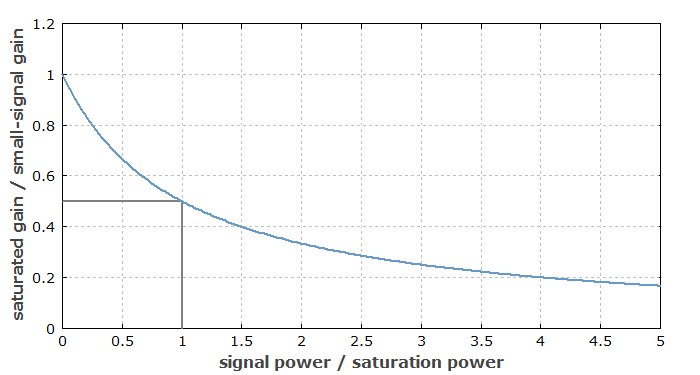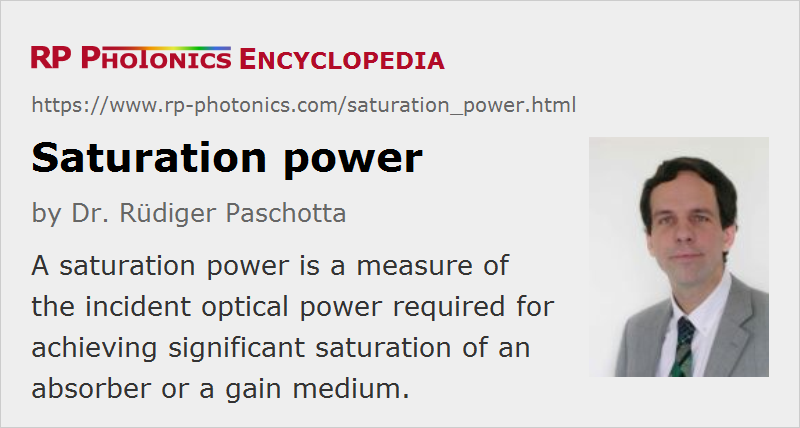Saturation Power
Definition: a measure of the incident optical power required for achieving significant saturation of an absorber or a gain medium
German: Sättigungsleistung
Category: physical foundations
Formula symbol: Psat
Units: W
How to cite the article; suggest additional literature
Author: Dr. Rüdiger Paschotta
The saturation power of a laser gain medium is the optical power of an input signal which in the steady state leads to a reduction in the gain to half of its small-signal value. Similarly, the saturation power of a saturable absorber is defined.
The saturation intensity is the corresponding optical intensity, i.e., the saturation power per unit area.
Usually it is assumed that the gain is small, i.e. input and output powers are similar. For high gain, it is common to refer to the output power.
For a low-gain laser amplifier, saturation intensity and power can be calculated according to
where h ν is the photon energy at the signal wavelength, σem and σabs are the emission and absorption cross sections at the emission wavelength, τ is the upper-state lifetime, and A is the mode area. The quantity σabs is zero for four-level gain media but should not be forgotten for quasi-three-level gain media.

A comparison with the equations for the saturation energy shows that the saturation power can be calculated as the saturation energy divided by the upper-state lifetime.
Importance of the Saturation Power
The saturation power plays an important role in various areas of laser physics and laser or amplifier design. Some examples are:
- It determines the amount of input power of an amplifier required for achieving most of the possible output power.
- The laser intensity in the gain medium of a four-level laser equals the saturation intensity if the pump power is twice the threshold pump power. This is remarkable, because the laser intensity in this situation is thus determined only by a property of the gain medium, not by resonator losses etc.
- For a saturable absorber, as used e.g. in a mode-locked laser, the ratio of continuous-wave intracavity power to saturation power is an important parameter for the initial pulse formation process.
The saturation power should not be confused with the saturated output power, which is usually not precisely defined but means the output power achieved for an input signal power which causes significant amplifier saturation. Obviously, the saturated output power (other than the saturation power) depends on the pump power.
Pump Saturation
A subtle detail is that the saturation characteristics can be modified if the pump intensity of the gain medium is comparable to or higher than the pump saturation power (which is defined as above, but based on photon energy and transition cross sections at the pump wavelength). In this situation, the rule that the gain is reduced by a factor of 2 for an intensity equal to the saturation intensity (as defined above) no longer holds.
For two reasons, however, pump saturation effects are in most cases not very important for lasers and amplifiers:
- In many solid-state bulk lasers, the pump intensity is well below the pump saturation intensity, so that such effects do not occur. (On the other hand, in certain fiber lasers such effects can be very strong.)
- Even if pump saturation is significant at some location within a laser crystal or amplifier, it may overall not be important, provided that the pump absorption within the whole gain medium is complete. In such a situation, local pump saturation simply means that some of the pump power is absorbed at another location within the same medium, effectively not changing the overall saturation characteristics.
Questions and Comments from Users
Here you can submit questions and comments. As far as they get accepted by the author, they will appear above this paragraph together with the author’s answer. The author will decide on acceptance based on certain criteria. Essentially, the issue must be of sufficiently broad interest.
Please do not enter personal data here; we would otherwise delete it soon. (See also our privacy declaration.) If you wish to receive personal feedback or consultancy from the author, please contact him e.g. via e-mail.
By submitting the information, you give your consent to the potential publication of your inputs on our website according to our rules. (If you later retract your consent, we will delete those inputs.) As your inputs are first reviewed by the author, they may be published with some delay.
See also: gain saturation, saturable absorbers, saturation energy, transition cross sections, The Photonics Spotlight 2008-01-06
and other articles in the category physical foundations
 |



If you like this page, please share the link with your friends and colleagues, e.g. via social media:
These sharing buttons are implemented in a privacy-friendly way!